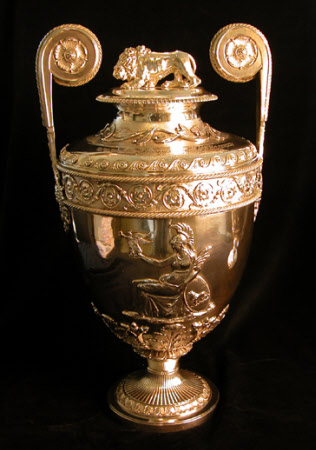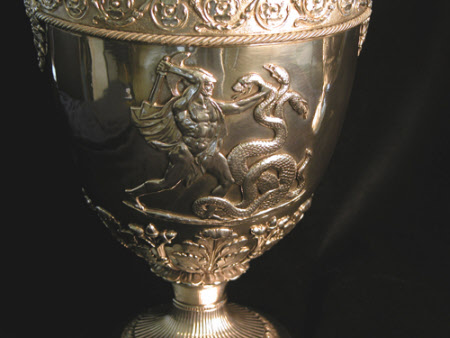Patriotic Fund Vase
Benjamin Smith
Date
1806 - 1807
Materials
Sterling silver
Measurements
39.6 x 22.5 cm; 20.1 cm (Diameter); 3580 g (weight); 37.8 cm (Height); 27 cm (Height); 20.1 cm (Diameter); 12.4 cm (Diameter)
Place of origin
London
Order this imageCollection
Anglesey Abbey, Cambridgeshire
NT 516502
Summary
A Patriotic Fund vase, silver (sterling), mark of Digby Scott & Benjamin Smith, for Rundell, Bridge & Rundell, London, 1806/7. Of Greek volute krater shape, the vase is formed of four parts, a two-handled cup, collar, cover and finial. The body of the cup is raised. It stands on a cast circular foot decorated with a narrow border of water leaves round a wide band of fluting, which supports a short stem, with an everted cast border of water leaves. The lower sides of the cup’s body are applied with cast and chased acanthus leaves alternating with sprigs of acorns. Applied above are large cast and chased figures representing Britannia and Hercules. The seated Britannia’s extended right hand supports the winged figure of Victory holding aloft a crown of laurel leaves; her left arm holds a sheaf of palm leaves and rests on her shield, which is charged with the British lion. On the opposite side a cloaked Hercules is depicted slaying the triple-headed Hydra. Beneath the rim of the vase two applied cable-laid (left twisted, as used on an anchor) ropework borders sit either side of an embossed and chased frieze of quatrefoils and meandering scrolling foliage on a matted ground. Rising vertically from the sides of the vase are two cast handles, rectangular in cross section and applied with a rope border; the top scrolls round a Tudor rose patera, whilst the base is attached to the body with a daisy-like patera partially surrounded by a ring of oak leaves and acorns. The detachable collar is raised and applied with a narrow flange. Its slightly domed sides are applied with a border of scrolling volutes, and another of leaves and berries on a matted ground, and at the everted lip of the wide spool-shaped top is a border of gadroons. The flat cover is raised and applied with a narrow flange. The large cast finial, in the form of a finely modelled lion passant, is secured with two screws. The collar is inscribed: ‘From the PATRIOTIC FUND at LLOYD’S/ TO THE HON ROBERT STOPFORD CAPTAIN OF H.M.S. SPENCER/ For his Meritorious Service in Contributing to the complete Victory/ OBTAINED OVER A SQUADRON/ OF FRENCH MEN OF WAR OFF ST. DOMINGO,/ on the 6TH of February, 1806’. Heraldry: None Recipient: Captain the Hon. Robert Stopford Hallmarks: Fully marked on the on the foot ring: ‘DS’ over ‘BS’ (Digby Scott & Benjamin Smith*), lion passant (sterling), leopard’s head (London), ‘L’ (1806/7), and monarch’s head (duty mark); part marked on the flange of the vase’s collar: ‘DS’ over ‘BS’, lion passant, and ‘L’; on the flange of the cover: ‘DS’ over ‘BS’, lion passant and ‘L’; on the back right leg of the lion: ‘DS’ over ‘BS’; and on the front right leg of the lion: monarch’s head and lion passant. (The nuts are not hallmarked.) Stamped on the foot ring: ‘RUNDELL BRIDGE ET RUNDELL AURIFICES REGIS ET PRINCIPIS WALLIAE LONDON’. *Arthur Grimwade: London Goldsmiths 1697-1837, 1990, p 46, no 505 Scratch weight: None Other marks: To identify the four parts of the vase they are all stamped with the number ‘10’.
Full description
NOTES ON PATRIOTIC FUND VASES On the same day in 1798 as the London Gazette announced Nelson’s victory over the French fleet at the Battle of the Nile, the Morning Chronicle carried an advertisement from Lloyd’s Coffee House announcing: ‘A subscription for the relief of the Widows and Children of the Brave Men who fell in the service of the KING and COUNTRY and for such as have been wounded in the glorious victory obtained by the British Fleet, under command of Rear Admiral Sir Horatio Nelson’. [1] This was not the first public subscription of its kind – numerous appeals had been run throughout the 18th century. Just five years’ later, in May 1803, after little more than a year’s peace with France, hostilities were renewed. In July Lloyd’s of London met ‘for the purpose of setting on foot a general subscription, on an extended scale, for the encouragement and relief of those who may be engaged in the defence of the country and who may suffer in the common cause.’ A committee, of what came to be known as the Patriotic Fund, was formed, with their resolutions published in a leaflet and newspapers, and funds sought. By August The Times was able to report that: ‘The Committee acknowledge with true patriotic pride that the Subscription exceeds any that has been recorded in the Annals of our History’. A competition was held to find suitable designs for the awards. The top prize of fifty guineas was won by the architect and artist, John Shaw (1776-1832) for his design for a vase, and by the painter, Edward Edwards (1738-1806) for his drawings for a medal. However, the committee wrote that the two winning designs were nearly the same, so both could serve ‘as the principal ornaments’ for both vase and medal. Anthony Twist suggests that this wording implies that Edwards’ design played some part in the final decoration of the vase. It is presumed that the drawings were passed to Rundell & Bridge, the crown jewellers, who were chosen to make the Patriotic Fund vases. They were an obvious choice. They were patronised by the chairman of the Patriotic Fund, John Angerstein (1735-1823; a Lloyds underwriter and businessman), the Corporation of London, Admiral Lord Nelson, and the British royal family. Rundell’s were in their ascendancy. ‘At its zenith no other firm could rival their business in the size of stock of silver, jewellery, snuffboxes or other luxury goods, nor in the immense capital they had accumulated.’ [2] They were also masters of the fashionable neo-classical style typified by the krater shape of the Patriotic Fund vase. They invited John Flaxman (1755-1826), the renowned sculptor and illustrator, to modify the winning design(s). Sadly, the drawings do not survive and without them we are unable tell how much Flaxman altered Shaw’s original design or how Edwards’ drawing of the medal may have influenced the shape or decoration of the vase. By 1815 the Patriotic Fund had raised £543,000, most of which had already been distributed to aid the injured and the families of those killed in battle. However, Patriotic Fund vases were only presented between 1804 and 1809. In total 73 vases were awarded, although a few more may have been produced. (There is one in the Victoria & Albert Museum which was never inscribed, so may have been surplus to requirements.) The first vase to be presented was valued at £30, and is of a traditional form with loop handles, probably because its creation predates the production of Flaxman’s vases. Most of the awards were for £100 vases, and all are of the same krater shape but with minor variations. The £300 and £500 vases are of the same design, but sometimes larger and on a stand, such as those awarded after Trafalgar to Lady Nelson, on the death of her husband, and to Vice-Admiral Lord Collingwood; both of which are now in the Royal Collection. The Admiralty and the War Office recommended the servicemen for deeds of outstanding leadership or marks of bravery. Their recommendations were then considered by the committee managing the fund. The names of the recipients were recorded, along with the date when the committee voted that they should receive the award, its value, the inscription, the final cost, and the date of delivery. Thirteen vases were awarded for the defeat of the French Fleet off St Domingo; one of £400, two of £300 (see 516501, The Patriotic Fund vase for Admiral Sir Alexander Cochrane KCB) and ten of £100. Captain the Hon. R Stopford was selected to receive a £100 vase on 25 March 1806, which was delivered in April 1809. [3] We do not know the reason for the delay between the award and delivery of the vase, but gaps of three to five, or even six years were not uncommon, perhaps because the recipient was abroad or still deciding between a sword or vase. Notes: [1] Anthony Twist: Towards The Patriotic Fund; The Journal of The Silver Society, 2010, No 26, pp 75-95 [2] Christopher Hartop: Royal Goldsmiths The Art of Rundell & Bridge 1797-1843, 2005, p 21 [3] Leslie Southwick: The Silver Vases Awarded to the Patriotic Fund: The Journal of The Silver Society Winter 1990, pp 27-49 NOTE ON ADMIRAL SIR ROBERT STOPFORD GCB GCMG Robert Stopford (1768-1847) was a distinguished officer in the Royal Navy whose career spanned over 60 years from the French Revolutionary Wars to the Syrian War. He was awarded his Patriotic Fund vase for his brilliant command of the Spencer at the Battle of San Domingo on 6 February 1806, where he forced the French ship, Alexandre to surrender. Despite suffering the deaths of eighteen men and fifty wounded – including himself – the next day Stopford sailed with his French prize to Jamaica. Stopford was the third son of James Stopford, second Earl of Courtown, and of his wife Mary Powys, a niece of the Duke of Montagu. He married Mary, daughter of Captain Robert Fanshawe, commissioner of the navy at Portsmouth; they had three sons and five daughters. During his long and successful naval service Stopford was awarded the Order of the Bath as KCB in 1815 and GCB in 1825, followed twelve years later, in 1837, with the GCMG. In addition to the Patriotic Fund vase he received the freedom of the City of London, a sword of honour from the Sultan of Turkey, and honours from Austria, Prussia, and Russia. In 1834 he was appointed rear-admiral of the United Kingdom. On retiring he became governor of the Royal Naval Hospital, Greenwich, a post that he held until his death. Retailer: Rundell, Bridge & Rundell, London, 1806/7
Provenance
Admiral Sir Robert Stopford GCB GCMG (1768-1847) (Urban) Huttleston Rogers Broughton, 1st Baron Fairhaven (1896-1966) bequeathed by Lord Fairhaven to the National Trust along with the house and the rest of the contents National Trust
Credit line
Anglesey Abbey, the Fairhaven Collection (National Trust)
Makers and roles
Benjamin Smith, goldsmith Rundell, Bridge and Rundell, goldsmith





